The AMD Ryzen Threadripper 3960X and 3970X Review: 24 and 32 Cores on 7nm
by Dr. Ian Cutress, Andrei Frumusanu & Gavin Bonshor on November 25, 2019 9:05 AM ESTPower Consumption
One of our key conclusions from our Ryzen 9 3950X review is that AMD’s TDP number on the box was now somewhat a blurred line, with the processor instead taking the ‘Package Power Tracking’ or PPT value as its true peak power consumption. This meant that for a processor to have 105 W TDP on the box, the default PPT of 142 W meant that we saw power consumption around 142 W rather than 105 W. One concern going into this review is that AMD would take a similar line with the Zen 2-based Threadripper parts as well.
Both of the TR 3960X and TR 3970X processors have a list box TDP of 280 W, which is a new ‘record’ for high power consumption in a consumer CPU. In the enterprise space we see some specialist processors break the 400W mark, but those CPUs exist in environments with a variety of cooling methods and sound isn’t much of a concern. Conversely, these AMD processors will have to live in a box under someone’s desk, so there has to be a point where the TDP is too much. Last AMD generation was 250W, this one is 280W: if we’re not there already, then this should be a practical limit. AMD of course recommends liquid cooling with a good pump and a big radiator, so anyone buying one of these processors should look into spending at least another $120+ on a good liquid cooling system.
For our power consumption metrics, we performed our usual testing: using an affinity mask to limit the cores in use, implement a high-powered workload, and then measure the power readings 30 seconds in. We take the power readings from the processor itself, using the internal registers that are designed to regulate how much the processor does a form of turbo but also regulate temperatures and so forth. This method is broadly accurate, assuming the motherboard supports the external reporting of these values, but depending on the processor family it also gives us insights into how much power is being derived from the cores individually and the package as a whole.
Here’s what we get for the 24-core 3960X:
When a single core is active, it consumes ~13.5 watts. This slowly goes down when more cores get loaded, but at 6 cores loaded we are still consuming ~12 watts per core. Even at 16 cores loaded, we’re still around 10 watts per core. This is pretty impressive. At full core loading, we’re fluctuating between 6 and 11 watts per core, as workloads get moved around to manage core loading.
From the peak power perspective, we hit 280 W with 22 cores loaded. It drops off a bit after that, like we saw with the Ryzen 9 3950X, but not by much at this time. It should be noted that as we reach these higher values, out of those 280 W, around 205 W is being used by the cores, while 75 W or so is for everything else: that means memory controllers, PCIe root complexes, and the infinity fabric. This 75 W value doesn’t vary that much, starting at 68 W even at single core load. This indicates that either IF doesn’t take much power as more cores are used, or it is on all the time.
Moving to the 3970X, and we see a similar picture:
With more cores, the power is spread around a lot more. One core loaded tops out at 13 watts, and at 11 cores loaded we can still manage above 10 watts per core. When fully loaded, we move down to as low as 3 W per core, but it does average out to around 6 watts per core. Checking the frequency at this loading and despite the 3.7 GHz base frequency, we actually have all the cores at 4.0 GHz. 32 cores at 4.0 GHz? Yes please.
The peak power metrics rise to just over 280 W when we hit 23 cores loaded and stay there, with no dip after hitting the peak. It would seem that the 3970X appears better built in that regard.
If we comment on the power between the cores and everything else, we again get a 205-210 W value for the power in the cores. This leaves 75 W or so for the rest of the chip, almost identical to the 3960X, and again this doesn’t waver much from 1 core loaded to all-cores loaded.
What will be interesting to see will be when we get the 3990X in to test as comparison. I expect that 75W value to go up – even if it goes to 100W, that leaves 180W for 64 cores, or around 3 W per core. Based on my estimates, we could be looking at anywhere from 3.0-3.5 GHz per core, which actually fits in nicely with the frequencies of the EPYC 7H12 which is also a 64-core 280W part, but for the high performance compute market.
When comparing peak power consumption to all the other CPUs in our review, as expected our new CPUs are near the top of the charts.
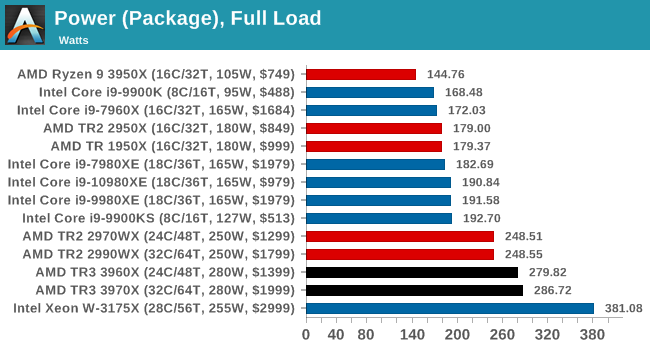
Only the unlocked 28-core from Intel peaks at a higher power, but funnily enough, that should only have a 255W TDP. So for four more cores, AMD’s peak power is still 100W below Intel’s. That’s the ‘power’ of the 7nm process node and some good quality chiplets.


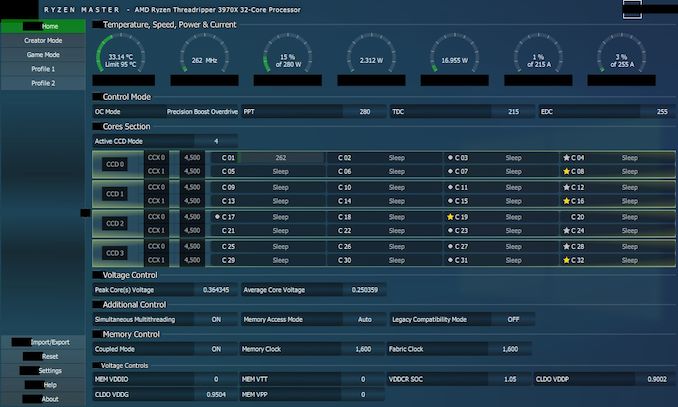
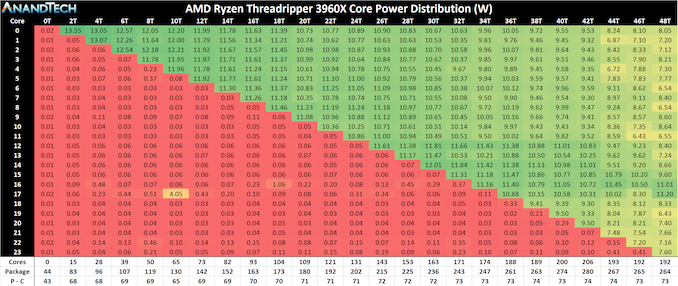
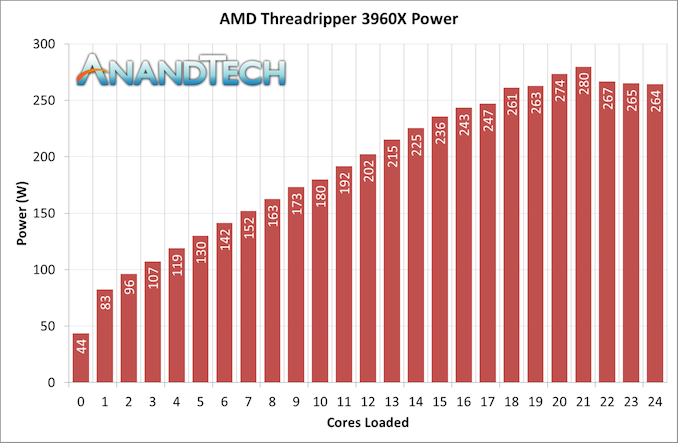
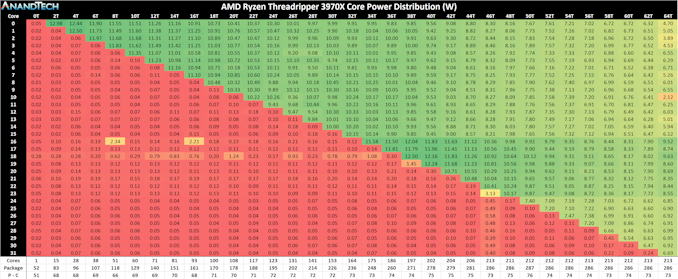
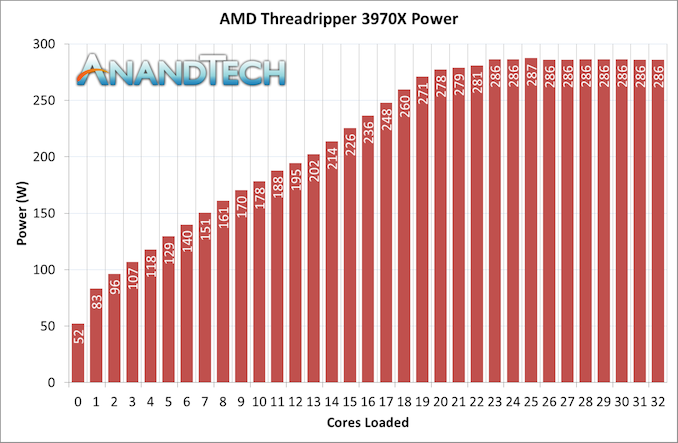








245 Comments
View All Comments
mkaibear - Monday, November 25, 2019 - link
Intel had revenue of 19.2bn last quarter. The highest it's ever been for them.https://www.anandtech.com/show/15030/intel-announc...
Claiming that Intel is destroyed is laughable.
They're hurting at the moment, but then they were hurting in the Athlon era as well... and that didn't go so badly for them in the end.
For reference, AMDs revenue for the same period was 1.8bn. yes, Intel, despite all their problems, earned *ten times* what AMD did.
(Reference: https://www.anandtech.com/show/15045/amd-q3-fy-201...
Claiming Intel are destroyed is just fanboyism at its worst.
Xyler94 - Monday, November 25, 2019 - link
Unless Intel can get something out sooner rather than later, people are migrating to AMD because they are pushing things forward. 64 cores of Epyc fury is hitting them in the Server Space, which is where Intel is most scared of. They don't care that you or I buy an Intel chip or an AMD one, they care if Microsoft or Apple buys either or.Intel isn't destroyed, but they will be hurting for a while, as AMD is showing no signs of slowing down, and Intel has to beat what AMD makes next, not AMD today.
mkaibear - Monday, November 25, 2019 - link
Again, Intel have record earnings this last quarter. As in over the last 3 months. As in after two years of AMD kicking their backside in the server space they're still making record amounts of revenue.Intel aren't stupid, they're one of the most ruthless companies in the sector. They can throw five times as much as AMD's *total profit* in R&D and still make five times as much profit as AMD does.
Xyler94 - Monday, November 25, 2019 - link
Record breaking earnings mean nothing in the grand scheme of things.For as much as you gloat about Intel's RND, AMD is the one who's on top in 2 of the 4 markets (Laptops, Desktops, HEDT and Servers), some would argue 3. Doesn't matter how much money you can throw at a problem, it matters if you can solve it. AMD solved the problem, Intel hasn't, and it's a frantic state at Intel to make something happen, either get 10nm working better or changing their uArch in 14nm.
Right now, the only reason to consider a XEON over an Epyc would be for AVX-512 only workloads. Because otherwise, ServerTheHome has shown that Epyc dominates, especially the 7742 64 core part.
SwackandSwalls - Monday, November 25, 2019 - link
Those record breaking earnings (i.e. capital) mean a lot, and saying otherwise displays a large and intentional ignorance on how important capital is to the microprocessor industry. Intel can use that money to hire more both hardware and software talent, fund more research, build more fabs, outspend AMD in marketing, and on and on. If Intel had huge cash reserves but was putting up large losses every quarter then I'd be on board with your "grand scheme of things" comment. In reality they are massively profitable, selling more 14nm chips than they can produce, and have enough cash to not only learn from AMD's successes but also invest in following suit.Xyler94 - Monday, November 25, 2019 - link
Again, Hire all you want, throw as much money as you want. That doesn't matter if there's no results.AMD with literally tenths of Intel's funding can beat them, and have found better ways to make processors to increase core counts without sacrificing efficiency. Intel also needs to spend a lot of money on researching the node itself, AMD doesn't, so not all of Intel's RnD goes to making the CPU, lots of it goes into making the node itself.
So while Intel may make more, they have to spend way more, especially since CPUs aren't the only thing Intel makes (They make flash chips, 3D XPoint, Networking chipsets, and many other products, all vying for that sweet RND cash)
So while Intel makes more, they also spend more. Revenue is a great figure to look at on paper, but it doesn't amount to anything unless the spending is done wisely. AMD surely has shown that it doesn't take Intel levels of cash to become a market leader and capitalize on someone who's grown complacent.
milkywayer - Monday, November 25, 2019 - link
"record breaking numbers mean a lot".So what happened then, why is AMDs offering more power and cost efficient at a much much lower price?
Korguz - Monday, November 25, 2019 - link
mkaibear/SwackandSwalls, and point is ?? intel has all that money, yet.. been milking the SAME architecture for how many years ? as Xyler94 already said.. to keep throwing money at a problem, and it STILL doesnt get fixed, is NOT a good thing. AMD may not have the money that your beloved intel does, but guess what, they have been able to do MORE with what they do have, so tell me who is spending wiser ?? also.. how much of that 19.2 billion has intel had to dump into their fabs??imaheadcase - Monday, November 25, 2019 - link
I really hope you are not comparing Intell vs amd based on a just a CPU..that is illogical.TEAMSWITCHER - Monday, November 25, 2019 - link
Intel isn't "hurting" now... Desktop processors are not what most people want.